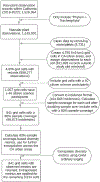Mapping wild vascular plant species diversity in urban areas in California using crowdsourcing data by regression kriging: Examining socioeconomic disparities
- PMID: 37717761
- PMCID: PMC10947671
- DOI: 10.1016/j.scitotenv.2023.166995
Mapping wild vascular plant species diversity in urban areas in California using crowdsourcing data by regression kriging: Examining socioeconomic disparities
Abstract
Biodiversity is crucial for human health, but previous methods of measuring biodiversity require intensive resources and have other limitations. Crowdsourced datasets from citizen scientists offer a cost-effective solution for characterizing biodiversity on a large spatial scale. This study has two aims: 1) to generate fine-resolution plant species diversity maps in California urban areas using crowdsourced data and extrapolation methods; and 2) to examine their associations with sociodemographic factors and identify subpopulations with low biodiversity exposure. We used iNaturalist observations from 2019 to 2022 to calculate species diversity metrics by exploring the sampling completeness in a 5 × 5-km2 grid and then computing species diversity metrics for grid cells with at least 80 % sample completeness (841 out of 4755 grid cells). A generalized additive model with ordinary kriging (GAM OK) provided moderately reliable estimates, with correlations of 0.64-0.66 between observed and extrapolated metrics, relative mean absolute errors of 21 %-23 %, and relative root mean squared errors of 27 %-30 % for grid cells with ≥80 % sample completeness from 10-fold cross-validation. GAM OK was further applied to extrapolate species diversity metrics from saturated grid cells (N = 841) to the remaining grid cells with <80 % sample completeness (N = 3914) and generate diversity maps that cover the grid. Further, generalized linear mixed models were used to examine the associations between species diversity and sociodemographic indicators at census tract level. The wild vascular plant species diversity metrics were inversely associated with neighborhood socioeconomic status (i.e., unemployment, linguistic isolation, educational attainment, and poverty rate). Minority populations (i.e., African American, Asian American, and Hispanic) and children had significantly lower diversity exposure in their neighborhoods. Crowdsourcing data offers a cost-effective solution for characterizing large-scale biodiversity in urban areas.
Keywords: Citizen science; Socio-economic status; Urban plant biodiversity; Vascular plant species diversity map.
Copyright © 2023 The Authors. Published by Elsevier B.V. All rights reserved.
Conflict of interest statement
Declaration of competing interest The authors declare that they have no known competing financial interests or personal relationships that could have appeared to influence the work reported in this paper.
Figures



Similar articles
-
Historical redlining is associated with disparities in wildlife biodiversity in four California cities.Proc Natl Acad Sci U S A. 2024 Jun 18;121(25):e2321441121. doi: 10.1073/pnas.2321441121. Epub 2024 Jun 11. Proc Natl Acad Sci U S A. 2024. PMID: 38861597 Free PMC article.
-
Phylogenetically informed spatial planning as a tool to prioritise areas for threatened plant conservation within a Mediterranean biodiversity hotspot.Sci Total Environ. 2019 May 15;665:1046-1052. doi: 10.1016/j.scitotenv.2019.02.127. Epub 2019 Feb 11. Sci Total Environ. 2019. PMID: 30893736
-
Global patterns of vascular plant alpha diversity.Nat Commun. 2022 Sep 1;13(1):4683. doi: 10.1038/s41467-022-32063-z. Nat Commun. 2022. PMID: 36050293 Free PMC article.
-
Globalizing and crowdsourcing biomedical research.Br Med Bull. 2016 Dec;120(1):27-33. doi: 10.1093/bmb/ldw044. Epub 2016 Nov 23. Br Med Bull. 2016. PMID: 27941038 Review.
-
How diverse are the mountain karst forests of Mexico?PLoS One. 2023 Oct 4;18(10):e0292352. doi: 10.1371/journal.pone.0292352. eCollection 2023. PLoS One. 2023. PMID: 37792775 Free PMC article. Review.
References
-
- Aronson MF, La Sorte FA, Nilon CH, Katti M, Goddard MA, Lepczyk CA, Warren PS, Williams NS, Cilliers S, Clarkson B, Dobbs C, Dolan R, Hedblom M, Klotz S, Kooijmans JL, Kühn I, Macgregor-Fors I, McDonnell M, Mörtberg U, Winter M, 2014. A global analysis of the impacts of urbanization on bird and plant diversity reveals key anthropogenic drivers. Proc. Biol. Sci 281 (1780), 20133330 10.1098/rspb.2013.3330. - DOI - PMC - PubMed
-
- Bae S, Levick SR, Heidrich L, Magdon P, Leutner BF, Wöllauer S, Serebryanyk A, Nauss T, Krzystek P, Gossner MM, Schall P, Heibl C, Bassler C, Doerfler I, Schulze E-D, Krah F-S, Culmsee H, Jung K, Heurich M, Müller J, 2019. Radar vision in the mapping of forest biodiversity from space. Nat. Commun 10 (1), 4757. 10.1038/s41467-019-12737-x. - DOI - PMC - PubMed

